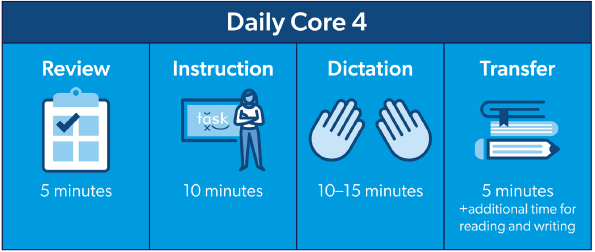
Without a robust phonics curriculum and support, teaching all the foundational reading strategies can be overwhelming for teachers and students. But, when the patterns of the English language get broken down into bite-sized pieces and taught with the multisensory approach using the gradual release of responsibility, learning to read and write becomes engaging, effective, and confidence-boosting.
Research also shows us that students need ample opportunities to practice the phonics skills they are learning to reach automaticity and have a solid reading foundation. We can expect that if moving explicitly, systematically, and sequentially, some students may get to that level of proficiency during the whole-group direct instruction lesson, while others don’t. Typical readers in second grade and above only need one to four appropriate exposures of a skill to orthographically map the patterns into their long-term memory (Kilpatrick, 2015). However, many students will still need additional exposure and practice of the skill to get to the same level of proficiency. Children with developmental language disorder (DLD), specifically those children formerly labeled as having specific language impairment (SLI), need two to three times as many exposures as their peers to support short-term word learning (i.e., training and immediate posttest; Gray, 2003; Rice, Oetting, Marquis, Bode, & Pae, 1994).
Therefore, providing students opportunities to engage in flexible small-group centers and transfer activities outside the typical 30-minute time block will provide a much-needed opportunity to differentiate instruction. It will also offer the multiple exposures needed to orthographically map the patterns that many learners need to master before moving forward in their scope and sequence. As a professional learning facilitator, I help teachers see that creating time for transfer opportunities results in students obtaining accuracy and proficiency faster and is key to foundational reading practice. This is critical since Reading Horizons, like all good teaching, meets students where they’re at and is paced to student mastery, not to a calendar. Without providing additional opportunities to orthographically map, our students can easily fall behind grade-appropriate content when they actually have the capacity to move ahead but just need more time to practice.
Here are some ideas on how you can enhance foundational reading skills through small-group centers.
First things first—if you already have centers in place, take inventory of what you have. It’s important to ask yourself the following questions: How are my centers aligned with what science proves is needed to acquire reading proficiency at the foundational reading level? Is the content my students are engaging in aligned with the scope and sequence of what I am teaching? Am I getting to the root of my struggling students’ reading difficulty to move them forward? How am I using student data to plan for differentiation?
As you begin to plan centers aligned with your explicit phonics instruction, use student data to plan for differentiated activities and differentiated time-blocks with the teacher. Studies suggest that skilled readers do reasonably well with independent activities, but lower readers learned substantially less from such activities (Connor, Morrison, & Petrella, 2004). Students who struggle need more time with equipped teachers and less time on their own. That is why center time is the perfect time for RTI interventionists to push in or pull out to facilitate aligned foundational reading support without leaving students floundering on their own.
Consider creating a center schedule that includes non-negotiable activities and student choice options for extended transfer of phonics skills each day. Although timed centers are often used in classrooms, Reading Horizons recommends allowing students to work at their own pace so they can complete one activity before moving on to the next. After non-negotiable centers are completed, allow students to choose the order of optional activities to increase student motivation.
|
Recommended Non-Negotiable Activities |
Recommended Optional Activities |
|---|---|
|
|
|
Note: Ensure activities, games, Practice Pages, etc., and content used in independent or student-led small-group centers are familiar to the students. Introduce concepts and activities during small-group or whole-class instruction. |
|
Because students may move between levels of proficiency depending on skills throughout the year, groups should remain flexible. Teachers should use daily observational and formal data to determine which students should be in each group. Group students according to their level of proficiency of the skills. If students are at different skill levels, it might make sense for the activities to remain the same but differ the skills being practiced with the activities. For example, in a kindergarten classroom, some students may focus on blending and segmenting CVC words while others focus on doing the same with blends or CCVC and CVCC word patterns. For students who already exhibit proficiency in a skill during a lesson, you can extend their practice through spelling and writing activities and focus on reading strategies geared around the Language Comprehension strands of Scarborough’s Reading Rope. This can be done using decodable or authentic text while others may need more time to practice word recognition skills within the text and scaffolding writing support.
It’s important to note that when students struggle with Decoding Skills, that is our indicator that we need to assess the underlying issue, which usually lies in a weak phonemic awareness. Phonemic proficiency tasks ensure students are effectively mapping the phonemes to their corresponding graphemes. If you’re like me, you’ve probably heard and even used the old phrase that “Phonemic awareness can be taught in the dark,” implying that phonemic awareness should not incorporate graphemes or the letters in practice. However, through the National Reading Panel’s meta-analysis, we now know that this is quite the contrary, and students benefit from incorporating letters to phonemic awareness practice (2000). Using Elkonin (sound) boxes and game chips, students can practice segmenting and blending phonics skill words. First, students listen to a word, then they segment the sounds one at a time while moving one chip per sound into the sound boxes. After they blend the sounds back together, they can replace the chips with letters and move from segmenting to blending again to orthographically map the word.
In the primary grades, providing time in your day for students to work in centers enables skills to be orthographically mapped while working in collaboration with peers or teachers. It is an intentional time where skills move from isolation into context and are supported through decodable text. This precious time is needed for student automaticity and fluency. Providing your students with these foundational reading skills gives them the cognitive bandwidth needed for comprehension.
How are you aligning the science of reading with your foundational reading centers?
